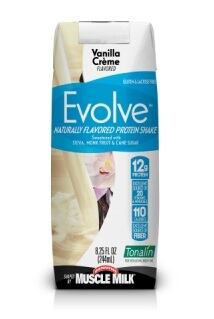The ingredient was recently highlighted by market analyst Euromonitor as a nutrient with a “key” role to play in the global weight management market. Numerous studies have shown CLA can help reduce body fat, maintain lean muscle mass and improve body composition.
“CLA is presently a missed mass market opportunity for foods and beverages and has been for some time,” said Dr A. Elizabeth Sloan from Sloan Trends. According to Sloan Trends’ 20 year-old predictive model TrendSense, the ingredient became a mass market in 2008.
“Whether this is the year of CLA is up to the industry, they’ve been missing these opportunities for some time now,” she told us.
Breakthrough?
The signs are positive for 2013, said Emile Henein, global business manager, for Stepan Lipid Nutrition, but “it is more likely that 2014 will see a greater penetration due to the product development timelines of companies, which are currently working on formulations.
“Some companies with shorter time to launch development programs will enjoy earlier market placement with CLA in foods and beverages.
“Another reason why we feel 2013 is a good year is due to the patented and branded activities of Stepan Lipid Nutrition and BASF, with Clarinol CLA and TonalinCLA.
“Stepan’s acquisition of Lipid Nutrition has provided a greater focus for the US market, while BASF has been busy with the acquisition of Cognis over the last couple of years. But it seems they have their integration behind them and now good plans to penetrate the food market with CLA, which actually complements our efforts in this area.
“It is also important to note that only Clarinol CLA and Tonalin CLA can provide the market with patent protected use of making CLA weight management claims. That certainly will provide additional confidence to major brands.”
Going national
While it has been in supplements for a number of years, CLA has a much shorter history in food and beverages, having only received GRAS (Generally Recognized as Safe) status in 2008.
Earlier this year, CytoSport, Inc., makers of Muscle Milk, launched a new protein shake containing BASF’s CLA for women with active, healthy lifestyles.

“Coupling protein with CLA in formulations is a very big idea,” said Dr Sloan. “Seventy-eight percent of consumers say protein helps build and maintain muscle, 68% believe protein helps increase lean muscle mass, according to Dairy Management Consumer Survey, 2012.”
The product, called Evolve, was said to be the first product of its kind to be launched with Tonalin CLA in North America, said Laura Troha, Tonalin CLA product manager, BASF Corporation, and the first food or beverage with the company’s CLA to be sold nationally in such a widespread retail market.
“The secret’s out!” Troha told us. “Food and beverage innovators have been closely monitoring the market data showing that consumers are increasingly aware of Tonalin’s effectiveness in improving body shaping.
“Our technical specialists have expertise in formulating Tonalin CLA in a variety of foods and beverages while maintaining the sensory aspects consumers expect, especially taste. And, that’s because we know that taste trumps all regardless of the noted health benefits.”
Dairy and beyond
Dairy and beverages continue to be the main applications for CLA. Jim Butterwick, VP specialty products for Stepan, explained that dairy products represent and natural fit for CLA, since a key CLA isomer is naturally present in cow milk, and the GRAS status of CLA for inclusion into dairy products will likely drive further product launches in the food industry for dairy beverages.
“In respect to beverage products in general, we can notice sports nutrition beverages that are based on protein to continue to add CLA to their formulations, particularly to leverage the weight management benefits of CLA, but also to tap into the newer scientific suggestions that CLA can improve endurance based on similar mechanisms with gene activity.
“In addition, for the general beverage market of meal replacements, juices, and smoothies such as Jamba Juice, (which also has safety approval under GRAS status), we can see additional interest to include CLA into those products for weight management claims.”
Sloan Trends’ Dr Sloan added: “Our guess is that the categories will broaden but stay close to those forms that are used in weight control and sports, meal replacement beverages/bars, cookies, etc.
“In pure form, CLA is bitter; but formulations can easily avoid problems associated with bitter taste, e.g., use of syrup form, etc.”
Stepan Lipid Nutrition is targeting 4 major demographic (age independent) populations for its Clarinol CLA for weight management benefits, added Henein.
“Certainly the overweight persons will benefit most from CLA weight management. Next, the two active lifestyle consumer groups who choose to improve lean muscle mass and maintain weight. Fourth, the more extreme consumer in the sports nutrition and muscle toning markets.”
And the kids?
Data from a clinical trial with children also makes kid’s food an attractive market, he said.
“Stepan Lipid Nutrition has a patent application specifically to the study this article refers to,” said Henein. “Our patent application was co-invented with support from researchers at the Univ of Wisconsin.
“Kid’s food is absolutely at attractive market which we plan to specifically promote to individual key brands, such as Pediasure which understands that market well.
“It is not a market that is likely to open up immediately such as children’s gummy bears Flintstone chewable vitamins.
“This application area may need additional studies to further articulate the benefits towards obese children, but also for children having CLA in their diets simply for optimal fat metabolism, as with adults.”
In response, Sloan Trends’ Dr Sloan said: “I simply don’t see the weight loss market for kids developing around CLA. Despite the high level of overweight and obesity in kids, there is no evidence to show that moms are motivated to buy products to help their kids lose weight.
“Our feeling is that adding ingredients to help children lose weight rather than encouraging standard exercise/dieting behaviors is unlikely to be a major trend.
“The way into the kids’ market as well as other markets is to connect CLA with protein. Thirty three million children are actively involved in sports.”
Patent protection
Patents are an important issues for CLA and weight management, said Henein, because only Stepan Lipid Nutrition and BASF have the respective licenses from WARF (Univ of Wisconsin) to market and sell CLA in food with Clarinol CLA and Tonalin CLA.

“Both Stepan Lipid Nutrition and BASF possess food application patents specifically for beverages, but other food products as well,” he said. “This patent landscape and brand protection certainly adds confidence and substance to various business plans that include new product launches within the food industry.
“It is likely that competitors, domestic and Asian, make attempts to penetrate the market and mislead consumer brand companies into potential patent infringements for unauthorized use of CLA claims around weight management.”
Opportunities
While awareness about the ingredient is increasing, Stepan said it feels there are still opportunities to improve the consumer understanding of CLA and its benefits for weight management/body sculpting towards the broader US mainstream consumer base.
“Over the past years, the Tonalin CLA brand from BASF (former Cognis) has done an exceptional job among the health food store sector to build awareness, and we believe they continue to do so,” said Henein.
Indeed, BASF’s Troha noted that the NMI Multi-Channel CLA Market Analysis for 2012 revealed that, “across all trade channels, BASF’s Tonalin brand is a clear market leader with a 60% dollar share of the total CLA market”.
Stepan is benefiting from arrangements with companies like GNC, said Henein. “Shortly following Stepan’s acquisition of Lipid Nutrition and Clarinol CLA brand in June 2011, greater awareness in the US is noticeable to consumers in the health food sector, specifically with our arrangements with GNC for the Clarinol CLA brand, which is included across their healthy life style products lines Total Lean, Pro Perfomance, Genetix, and the Marked lines,” he said.
“In addition, greater awareness is expected as the sports nutrition market continues to add CLA to their product lines, which complement the weight management categories.”
Current markets
Henein noted that the current market in the US for CLA is estimated at about 850 metric tons or about $33 Million at the ingredient level.
“Product containing CLA at the retail level are better measured by retail players, but our estimates for retail sales are about $125 million, excluding the effects of MLM based companies (which often skew the retail estimates higher),” he said.
“However, we believe that only fiber related products have more studies to support weight management than CLA, but with a different mechanism.”
Deep science
And how well elucidated is CLA’s mechanism of action? Not 100%, said Dr Hiskias Keizer, senior scientist at Stepan Lipid Nutrition.
“However, based on numerous studies, scientists believe that a likely mechanism involves partial agonistic (stimulating) effects of CLA on nuclear PPAR-gamma receptors in fat cells (adipocytes). PPAR-gamma receptors regulate fat accumulation and fat metabolism in adipocytes, resulting in reduced fat accumulation in these cells.
“Since other molecules, which share with CLA their partial agonistic effects on PPAR gamma receptors, have similar effects on fat-cells, it is likely that partial agonism on PPAR gamma receptors on adipocytes is sufficient to explain the effects of CLA on fat-loss.
“CLA may also affect other nuclear receptors like PPAR alpha. However since CLA also induces fat loss in PPAR alpha knock out animals, the PPAR alpha is probably not required for fat-loss.
“In conclusion, partial agonistic effects of CLA on PPAR gamma receptors are sufficient to explain CLA effects on fat-loss. Whether PPAR gamma partial agonism is the only mechanism of CLA to reduce body fat is unclear at this moment.”
Lifestyle
While the “how?” is still to be totally clarified, the “what?” is backed up by numerous clinical trials.
Dr Keizer added that CLA can be added to a normal diet in a normal life style to reduce body fat substantially.
“Data suggest that CLA may induce more body fat loss if it is used in combination with exercise (more fat-loss than induced with exercise alone), but exercise is not required to induce fat-loss with dietary CLA. Best fat loss effects are observed in overweight people with a BMI of 25-30.”
